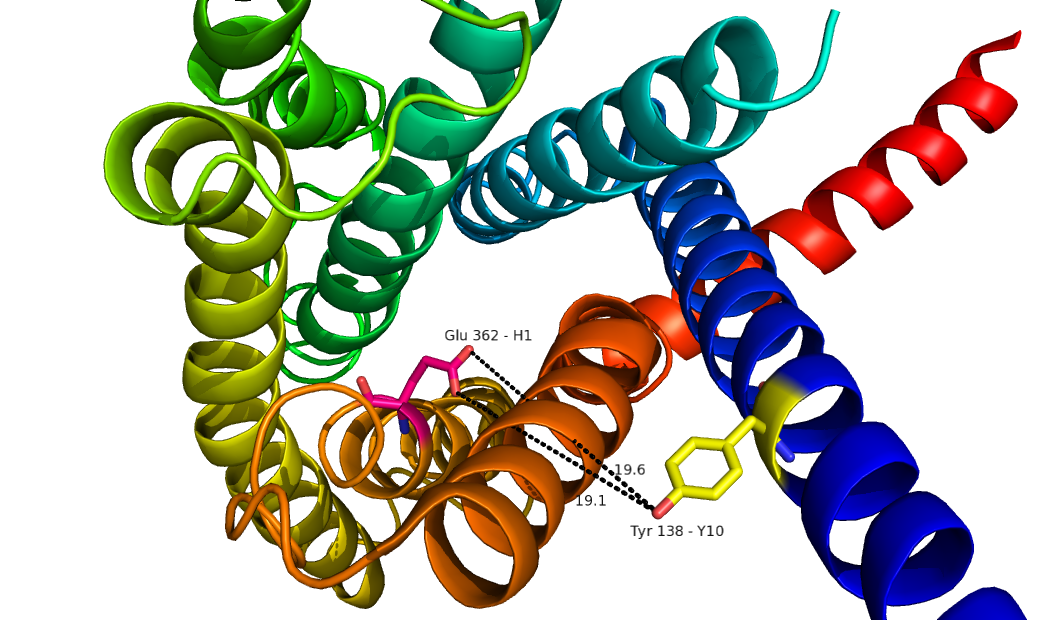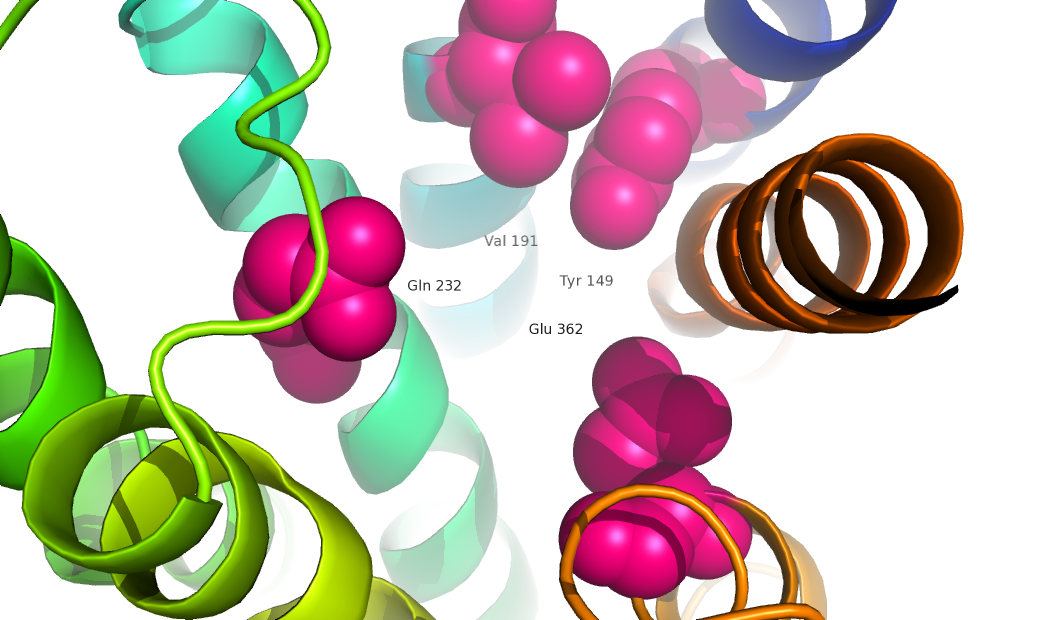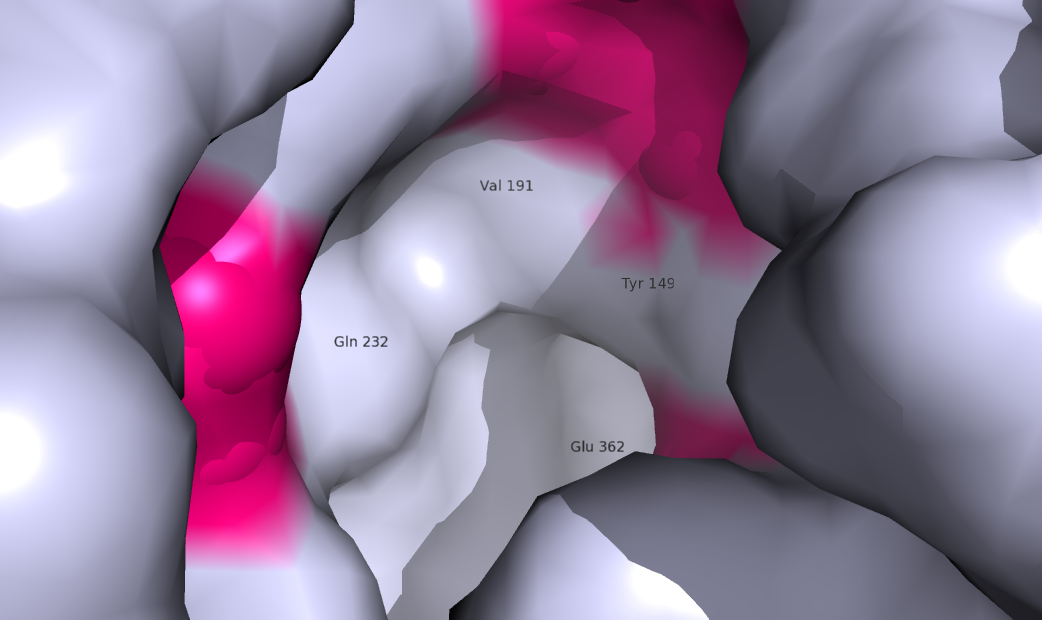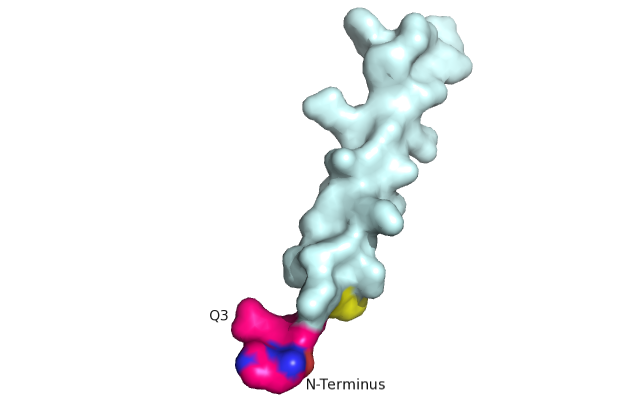User:Dean Williams/Sandbox 1180
From Proteopedia
| Line 3: | Line 3: | ||
| - | Class B GPCRs contain 15 distinct receptors for peptide hormones and generate their signal pathway through the activation of adenylate cyclase (AC) which increases concentration of cAMP, inositol phosphate, and calcium levels in cyto. <ref>DOI 10.1111/bph.12689</ref> These signals are essential elements of intracellular signal cascades for human diseases including type II diabetes mellitus, osteoporosis, obesity, cancer, neurological degeneration, cardiovascular diseases, headaches, and psychiatric disorders; making their regulation through drug targeting of particular interest to companies developing novel molecules. <ref>DOI 10.1016/j.tips.2013.11.001</ref> Structurally based approaches to the development of small-molecule agonists and antagonists have been hampered by the lack of accurate Class B TMD visualizations until recent crystal structures of corticoptropin-releasing factor receptor 1 and human glucagon were realized. <ref>DOI 10.1038/nature12357</ref> <ref>DOI 10.1038/nature12393</ref> | + | Class B GPCRs contain 15 distinct receptors for peptide hormones and generate their signal pathway through the activation of adenylate cyclase (AC) which increases concentration of cAMP, inositol phosphate, and calcium levels in cyto. <ref>DOI 10.1111/bph.12689</ref> These signals are essential elements of intracellular signal cascades for human diseases including type II diabetes mellitus, osteoporosis, obesity, cancer, neurological degeneration, cardiovascular diseases, headaches, and psychiatric disorders; making their regulation through drug targeting of particular interest to companies developing novel molecules. <ref name= "Hollenstein 2014">DOI 10.1016/j.tips.2013.11.001</ref> Structurally based approaches to the development of small-molecule agonists and antagonists have been hampered by the lack of accurate Class B TMD visualizations until recent crystal structures of corticoptropin-releasing factor receptor 1 and human glucagon were realized. <ref>DOI 10.1038/nature12357</ref> <ref>DOI 10.1038/nature12393</ref> |
The glucagon class B GPCR (GCGR) is involved in glucose homeostasis through the binding of the signal peptide glucagon. | The glucagon class B GPCR (GCGR) is involved in glucose homeostasis through the binding of the signal peptide glucagon. | ||
| Line 20: | Line 20: | ||
==Comparisons to other G proteins== | ==Comparisons to other G proteins== | ||
| - | The class B GPCR GCGR is different from other Class A GPCRs in several ways. The first is that GCGR has a protrusion known as a 'stalk' which is a three helical turn elongation of the N-terminus that protrudes past the extracellular (EC) membrane. ((CAN WE INSERT LINK TO 2D PIC HERE??)) Secondly, the extracellular loop 1 (ECL1) is 3-4 times longer than comparable loops in class A GPCRs. Through mutagenesis studies, the stalk and ECL1 have been determined to affect ligand-receptor interaction. <ref>DOI 10.1038/nature12393</ref> ((INSERT 2D PIC OF STALK ACTIVE RESIDUES AND ECL1 ACTIVE RESIDUES)) Most notably, GCGR contains a prominent central splay which is solvent filled and accessible from the extracellular side. This central splay is notably absent from class A GPCRs and represents a tantalizing target for agonists/antagonists and is the focus of much current research into GCGR signal regulation. <ref | + | The class B GPCR GCGR is different from other Class A GPCRs in several ways. The first is that GCGR has a protrusion known as a 'stalk' which is a three helical turn elongation of the N-terminus that protrudes past the extracellular (EC) membrane. ((CAN WE INSERT LINK TO 2D PIC HERE??)) Secondly, the extracellular loop 1 (ECL1) is 3-4 times longer than comparable loops in class A GPCRs. Through mutagenesis studies, the stalk and ECL1 have been determined to affect ligand-receptor interaction. <ref>DOI 10.1038/nature12393</ref> ((INSERT 2D PIC OF STALK ACTIVE RESIDUES AND ECL1 ACTIVE RESIDUES)) Most notably, GCGR contains a prominent central splay which is solvent filled and accessible from the extracellular side. This central splay is notably absent from class A GPCRs and represents a tantalizing target for agonists/antagonists and is the focus of much current research into GCGR signal regulation. <ref name= "Hollenstein 2014"> |
===Structural similarities AND DIFFERENCES between class A and class B GPCRs=== | ===Structural similarities AND DIFFERENCES between class A and class B GPCRs=== | ||
| Line 52: | Line 52: | ||
GPCR activity is regularly quantified by ligand binding affinity, potency, efficacy, and kinetics. These measurement are used to measure drug ligand interactions in vivo. Recently, GPCRs have been crystallized and catalogued, which tend to include a need to stabilize the receptor, emphasizing the instability of the G coupled protein receptor. Zhang et. al. imply the importance of receptor folding in the cell membrane, in the human class B GPCR the 7TM portion, for receptor stability and function. <ref>DOI 10.1016/j.tibs.2014.12.005</ref> | GPCR activity is regularly quantified by ligand binding affinity, potency, efficacy, and kinetics. These measurement are used to measure drug ligand interactions in vivo. Recently, GPCRs have been crystallized and catalogued, which tend to include a need to stabilize the receptor, emphasizing the instability of the G coupled protein receptor. Zhang et. al. imply the importance of receptor folding in the cell membrane, in the human class B GPCR the 7TM portion, for receptor stability and function. <ref>DOI 10.1016/j.tibs.2014.12.005</ref> | ||
| - | == | + | ==The Signal Peptide: Glucagon== |
| - | + | ||
| - | + | ||
| - | + | ||
| - | + | ||
| - | + | ||
| - | + | ||
| - | + | ||
| - | + | ||
| - | + | ||
| - | + | ||
===Biological function of glucagon=== | ===Biological function of glucagon=== | ||
| - | Glucagon | + | Glucagon, a signaling ligand in the metabolic pathway, has three main biological functions. |
| - | + | Glucagon regulates the production of cholesterol, which is an energetically intensive process. When energy resources are low, downregulation of cholesterol production begins with glucagon binding to GCGR which stimulates the phosphorylation of HMG-CoA. Once the HMG-CoA has been phosphorylated, it is inactivated and cholesterol production is moderated to conserve energy. | |
| - | + | Glucagon also takes part in fatty acid mobilization by affecting levels of adipose tissue in the organism. Activation of GCGR by glucagon initiates triacylglycerol breakdown and the phosphorylation of perilipin and lipases via cAMP. This allows the body to export the fatty acid to the liver and other crucial tissues for energy use and makes more glucose available for use in brain functioning. Through these processes, glucagon is able to increase glucose levels in the blood. Glucagon lowers the concentration of fructose 2,6-bisphosphate in the blood, which is an allosteric inhibitor of gluceogenesis. Glucagon also promotes the functioning of the enzyme fructose 1,6-bisphosphotase and activates phosphofructose kinase 1, which increases glucose levels via glycolysis. | |
| - | + | <ref name = 'Lehninger'>'Lehninger A., Nelson D.N, & Cox M.M. (2008) Lehninger Principles of Biochemistry. W. H. Freeman, fifth edition.' </ref> | |
| - | + | (Nelson & Cox, Principles of Biochemistry, 2008) | |
| + | ===Glucagon Peptide Stability and Active Binding Sites=== | ||
| + | Essential, conserved residues of glucagon, as discovered through mutagenesis and photo cross-linking studies have been labeled and colored in red. <ref>DOI 10.1038/nature12393</ref> | ||
| - | + | <scene name='72/727091/Glucagon_important_residues/2'>Important stability/active sites <ref>DOI 10.1038/nature12393</ref></scene> | |
| - | Glucagon affects adipose tissue | ||
| - | + | ===Active binding domains/sites=== | |
| + | [[Image:Movie Frame 8.png]][[Image:Movie Frame 3.png]][[Image:Movie Frame 6.png]][[Image:Glucagon with Q3 and N-terminus.png]] | ||
| - | cAMP dependent phosphorylation of perilipin and hormone sensitive lipases | ||
| - | Fatty acid exported to liver and other tissues for energy use | ||
| - | |||
| - | More glucose available for brain use | ||
| - | |||
| - | |||
| - | Increases blood glucose levels | ||
| - | |||
| - | Lowers the concentration of fructose 2,6-bisphospate in blood – allosteric inhibitor of the gluconeogenic | ||
| - | enzyme fructose 1,6-bisphosphotase | ||
| - | |||
| - | Activates phosphofructose kinase 1 – glycolytic enzyme increases glucose levels | ||
| - | |||
| - | <ref name = 'Lehninger'>'Lehninger A., Nelson D.N, & Cox M.M. (2008) Lehninger Principles of Biochemistry. W. H. Freeman, fifth edition.' </ref> | ||
| - | |||
| - | (Nelson & Cox, Principles of Biochemistry, 2008) | ||
===Signaling pathways=== | ===Signaling pathways=== | ||
| Line 104: | Line 80: | ||
==Clinical relevance== | ==Clinical relevance== | ||
| - | Class B secretin-like receptors have gained relevance in therapeutics and drug targets. Maintaining information about the class B GPCRs conformational flexibility, allows for a better understanding of the receptor-ligand binding and its pharmaceutical relevance. The 7TM structure offers a direct connect between the extracellular and intracellular region, which offers a mechanism for signal transduction within the cell. GPCRs regulate cellular processes as required by the organs in which they are located. GPCR’s are used in the functioning of neuron synapses, ion transport regulation, homeostasis, cell division, and cell morphology. Mutations in the GPCR have been linked with retinitis pigmentosa, female infertility, nephrogenic diabetes insipidus, and familial exudative vitreoretinopathy. <ref>DOI 10.1124/pr.110.003350</ref> | + | Class B secretin-like receptors have gained relevance in therapeutics and drug targets. Maintaining information about the class B GPCRs conformational flexibility, allows for a better understanding of the receptor-ligand binding and its pharmaceutical relevance. The 7TM structure offers a direct connect between the extracellular and intracellular region, which offers a mechanism for signal transduction within the cell. GPCRs regulate cellular processes as required by the organs in which they are located. GPCR’s are used in the functioning of neuron synapses, ion transport regulation, homeostasis, cell division, and cell morphology. Mutations in the GPCR have been linked with retinitis pigmentosa, female infertility, nephrogenic diabetes insipidus, and familial exudative vitreoretinopathy. <ref name= "Salon 2011">DOI 10.1124/pr.110.003350</ref> |
===Future research direction=== | ===Future research direction=== | ||
| - | Research for Class A GPCRs is much more extensive than for its secretin, class B counterparts, although class B is proving to be a worthwhile to invest researching. The challenge of class B stabilization, expression, and molecular size , has made class B GPCRs particularly hard to assay. Biochemical research has increased in the class B specifications, because it has been realized that receptors can be modulated by more than the agonist and antagonists present in vivo. Leading research consists of a complex interwoven scheme of equilibria manipulation in multi-receptor conformations. <ref | + | Research for Class A GPCRs is much more extensive than for its secretin, class B counterparts, although class B is proving to be a worthwhile to invest researching. The challenge of class B stabilization, expression, and molecular size , has made class B GPCRs particularly hard to assay. Biochemical research has increased in the class B specifications, because it has been realized that receptors can be modulated by more than the agonist and antagonists present in vivo. Leading research consists of a complex interwoven scheme of equilibria manipulation in multi-receptor conformations. <ref name="Salon 2011"/> |
===Current drug targets=== | ===Current drug targets=== | ||
Revision as of 18:22, 1 April 2016
Structure of Class B Human Glucagon G-Protein Coupled Receptors (GCGRs)
G protein coupled receptors (GPCRs) are recognized as the largest known class of integral membrane proteins and are divided into five families; the rhodopsin family (class A), the secretin family (class B), the adhesion family, the glutamate family (class C), and the frizzled/taste family (class F). Roughly 5% of the human genome encodes g-protein-coupled receptors which are responsible for the transduction of endogenous signals and the instigation of cellular response. The variants all contain a similar seven α-helical transmembrane domain (TMD) that, once bound to its peptide ligand, undergoes conformational change and tranduces a signal to coupled, heterotrimeric G proteins which initiate intracellular signal pathways and generate physiological and pathological processes. [1]
Class B GPCRs contain 15 distinct receptors for peptide hormones and generate their signal pathway through the activation of adenylate cyclase (AC) which increases concentration of cAMP, inositol phosphate, and calcium levels in cyto. [2] These signals are essential elements of intracellular signal cascades for human diseases including type II diabetes mellitus, osteoporosis, obesity, cancer, neurological degeneration, cardiovascular diseases, headaches, and psychiatric disorders; making their regulation through drug targeting of particular interest to companies developing novel molecules. [3] Structurally based approaches to the development of small-molecule agonists and antagonists have been hampered by the lack of accurate Class B TMD visualizations until recent crystal structures of corticoptropin-releasing factor receptor 1 and human glucagon were realized. [4] [5]
The glucagon class B GPCR (GCGR) is involved in glucose homeostasis through the binding of the signal peptide glucagon.
| |||||||||||
References
- ↑ Zhang Y, Devries ME, Skolnick J. Structure modeling of all identified G protein-coupled receptors in the human genome. PLoS Comput Biol. 2006 Feb;2(2):e13. Epub 2006 Feb 17. PMID:16485037 doi:http://dx.doi.org/10.1371/journal.pcbi.0020013
- ↑ Bortolato A, Dore AS, Hollenstein K, Tehan BG, Mason JS, Marshall FH. Structure of Class B GPCRs: new horizons for drug discovery. Br J Pharmacol. 2014 Jul;171(13):3132-45. doi: 10.1111/bph.12689. PMID:24628305 doi:http://dx.doi.org/10.1111/bph.12689
- ↑ 3.0 3.1 Hollenstein K, de Graaf C, Bortolato A, Wang MW, Marshall FH, Stevens RC. Insights into the structure of class B GPCRs. Trends Pharmacol Sci. 2014 Jan;35(1):12-22. doi: 10.1016/j.tips.2013.11.001. Epub, 2013 Dec 18. PMID:24359917 doi:http://dx.doi.org/10.1016/j.tips.2013.11.001
- ↑ Hollenstein K, Kean J, Bortolato A, Cheng RK, Dore AS, Jazayeri A, Cooke RM, Weir M, Marshall FH. Structure of class B GPCR corticotropin-releasing factor receptor 1. Nature. 2013 Jul 25;499(7459):438-43. doi: 10.1038/nature12357. Epub 2013 Jul 17. PMID:23863939 doi:http://dx.doi.org/10.1038/nature12357
- ↑ Siu FY, He M, de Graaf C, Han GW, Yang D, Zhang Z, Zhou C, Xu Q, Wacker D, Joseph JS, Liu W, Lau J, Cherezov V, Katritch V, Wang MW, Stevens RC. Structure of the human glucagon class B G-protein-coupled receptor. Nature. 2013 Jul 25;499(7459):444-9. doi: 10.1038/nature12393. Epub 2013 Jul 17. PMID:23863937 doi:10.1038/nature12393
- ↑ Yang DH, Zhou CH, Liu Q, Wang MW. Landmark studies on the glucagon subfamily of GPCRs: from small molecule modulators to a crystal structure. Acta Pharmacol Sin. 2015 Sep;36(9):1033-42. doi: 10.1038/aps.2015.78. Epub 2015, Aug 17. PMID:26279155 doi:http://dx.doi.org/10.1038/aps.2015.78
- ↑ Ahren B. Islet G protein-coupled receptors as potential targets for treatment of type 2 diabetes. Nat Rev Drug Discov. 2009 May;8(5):369-85. doi: 10.1038/nrd2782. Epub 2009 Apr, 14. PMID:19365392 doi:http://dx.doi.org/10.1038/nrd2782
- ↑ Xu Y, Xie X. Glucagon receptor mediates calcium signaling by coupling to G alpha q/11 and G alpha i/o in HEK293 cells. J Recept Signal Transduct Res. 2009 Dec;29(6):318-25. doi:, 10.3109/10799890903295150. PMID:19903011 doi:http://dx.doi.org/10.3109/10799890903295150
- ↑ Siu FY, He M, de Graaf C, Han GW, Yang D, Zhang Z, Zhou C, Xu Q, Wacker D, Joseph JS, Liu W, Lau J, Cherezov V, Katritch V, Wang MW, Stevens RC. Structure of the human glucagon class B G-protein-coupled receptor. Nature. 2013 Jul 25;499(7459):444-9. doi: 10.1038/nature12393. Epub 2013 Jul 17. PMID:23863937 doi:10.1038/nature12393
- ↑ 'Lehninger A., Nelson D.N, & Cox M.M. (2008) Lehninger Principles of Biochemistry. W. H. Freeman, fifth edition.'
- ↑ Siu FY, He M, de Graaf C, Han GW, Yang D, Zhang Z, Zhou C, Xu Q, Wacker D, Joseph JS, Liu W, Lau J, Cherezov V, Katritch V, Wang MW, Stevens RC. Structure of the human glucagon class B G-protein-coupled receptor. Nature. 2013 Jul 25;499(7459):444-9. doi: 10.1038/nature12393. Epub 2013 Jul 17. PMID:23863937 doi:10.1038/nature12393
- ↑ Weston C, Lu J, Li N, Barkan K, Richards GO, Roberts DJ, Skerry TM, Poyner D, Pardamwar M, Reynolds CA, Dowell SJ, Willars GB, Ladds G. Modulation of Glucagon Receptor Pharmacology by Receptor Activity-modifying Protein-2 (RAMP2). J Biol Chem. 2015 Sep 18;290(38):23009-22. doi: 10.1074/jbc.M114.624601. Epub, 2015 Jul 21. PMID:26198634 doi:http://dx.doi.org/10.1074/jbc.M114.624601
- ↑ 13.0 13.1 Salon JA, Lodowski DT, Palczewski K. The significance of G protein-coupled receptor crystallography for drug discovery. Pharmacol Rev. 2011 Dec;63(4):901-37. doi: 10.1124/pr.110.003350. PMID:21969326 doi:http://dx.doi.org/10.1124/pr.110.003350





